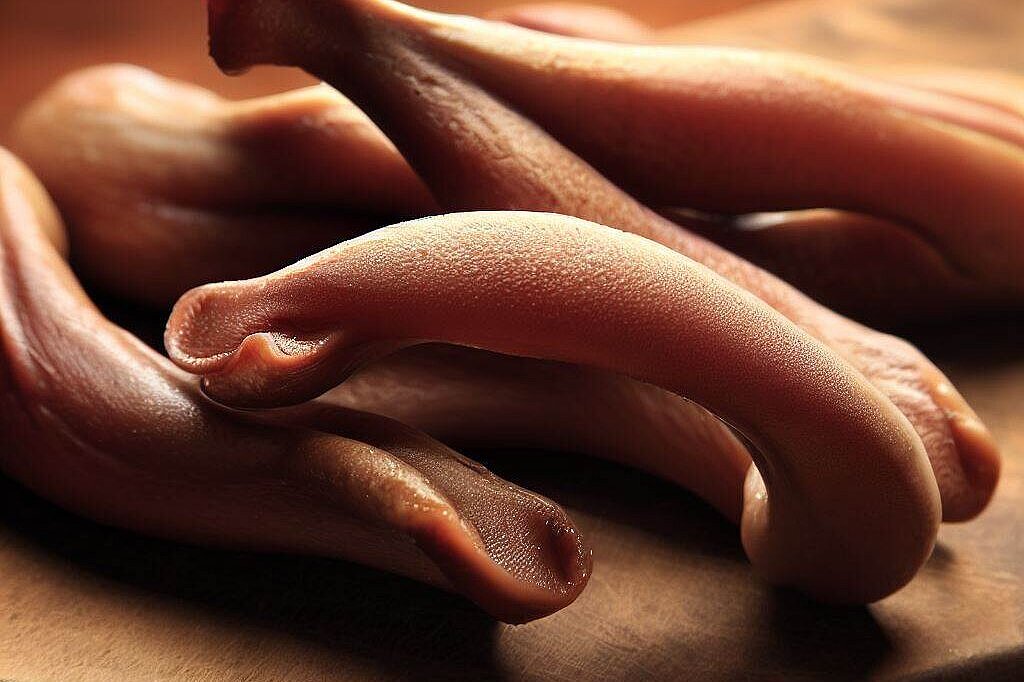Duck feet

What are duck feet?
Duck feet are the feet of ducks that are a by-product of slaughtering. They consist of skin, cartilage, bones and nails. The bones are soft and do not splinter, so they can be easily digested by dogs. The nails may look sharp, but they are also digestible and harmless.
How are duck feet for dogs prepared?
Duck feet for dogs are usually offered dried or freeze-dried. They are heated to high temperatures to kill bacteria and extend their shelf life. The drying process makes the duck feet crispy and tasty. Some manufacturers also offer raw duck feet frozen. These must be defrosted before feeding.
What are the benefits of duck feet for dogs?
Duck feet have many benefits for the health and well-being of dogs. Here are some of them:
- They are a natural source of glucosamine and chondroitin, which are important for joint health. These substances can prevent or alleviate osteoarthritis.
- They are rich in proteins, which are important for muscle building and the immune system. Duck protein is a high-quality protein that contains all the essential amino acids.
- They are low in fat and calories and therefore also suitable for overweight or sensitive dogs.
- They are hypoallergenic, i.e. they rarely cause allergies. Duck is a rare source of protein that is often tolerated by dogs with food intolerances.
- They are good for dental hygiene as they remove plaque and massage the gums when chewed. This can prevent tartar build-up and bad breath.
- They are a species-appropriate activity that satisfies the natural urge to chew and reduces stress. Boredom and undesirable behavior can be avoided.
What are the disadvantages of duck feet for dogs?
Duck feet also have some disadvantages or risks for dogs. Here are some of them:
- They can contain salmonella or other pathogens if not processed properly. Therefore, you should only buy high-quality products from trustworthy manufacturers and pay attention to the best-before date.
- Duck feet can cause diarrhea or vomiting if your dog eats too much of it or is not used to it. Therefore, you should only feed duck feet as an occasional snack and adjust the amount.
- They can cause injury to the mouth or digestive tract if your dog eats them too quickly or too greedily. Therefore, you should always monitor your dog when chewing duck feet and provide them with plenty of water.
- They can lead to an overdose of glucosamine or chondroitin if your dog is already receiving a supplement containing these substances.
If you notice any signs of hypersensitivity or poisoning in your dog, you should see your vet immediately. We are not a substitute for a vet, but we try to be as accurate as possible. Every dog reacts differently and we recommend you get a second opinion or consult your vet if in doubt.
Stay healthy and take good care of your four-legged friend!😊
Similar to Duck feet
Chicken feet are dried or fresh chicken feet that can be used as a chew for dogs. They consist mainly of cartilage, skin and nails and contain little fat and calories. Chicken feet are naturally...
Duck meat is the muscle meat of domestic and wild ducks. It is a type of poultry meat and has a high protein content. It also contains many important nutrients such as iron, zinc, selenium and B...
Duck cartilage is the connective tissue that binds the bones of ducks together. It consists mainly of collagen, a protein responsible for the elasticity and strength of skin, hair, nails and joints....
Duck necks are poultry parts consisting of the neck and head of the duck. They are usually offered dried or frozen and can be fed whole or cut into pieces. Duck necks contain a lot of meat,...



